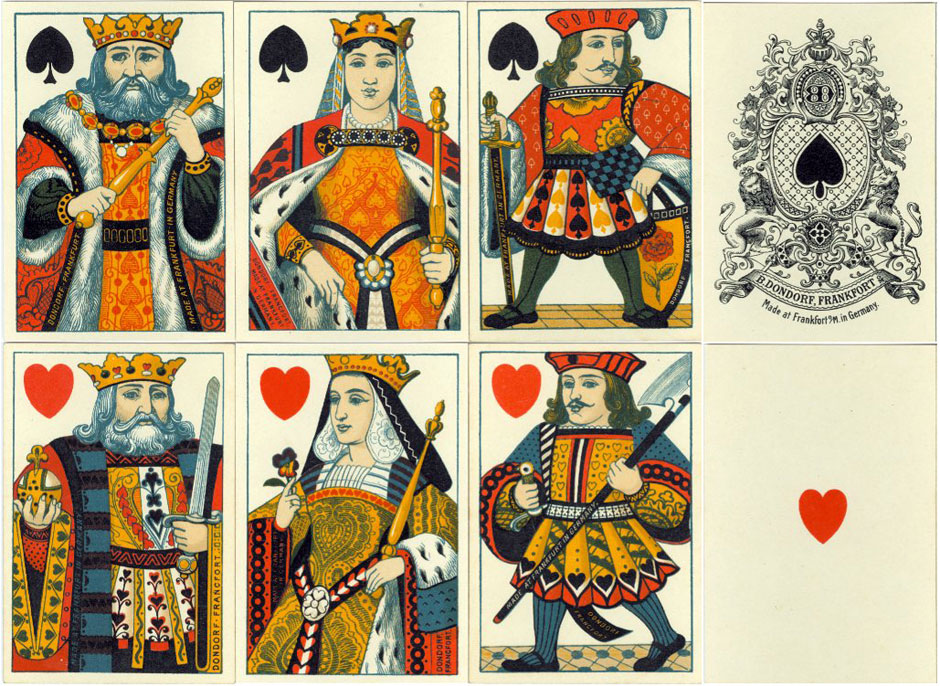Birma Karte or Englische Karten
Based upon older ‘standard’ patterns, the Kings and Queens are three-quarter length figures whilst the Jacks are full-length with legs giving the impression that they are walking about!
B. Dondorf: ‘Birma Karte No.194’ - for export to British colonies (1867-1920)
Single-ended (full-length) courts were common in the early 19th century, but were gradually replaced by double-ended courts. Both forms coexisted during this period. Single-ended English cards by Dondorf were primarily intended for export to England and its colonies, especially to Burma. For this reason they do not appear in regular price lists. All the costumes are elaborately decorated.
Whilst several manufacturers were experimenting with decorated versions of the standard International pattern*, this is definitely the most remarkable example designed by Dondorf. Examples are known with wrappers printed for Hegt & Co. Trading Company, Rangoon (Burma).


Above: Dondorf's “Birma Karte No.194” printed by chromolithography for exportation to British and other colonies, 1867-1920. 52 cards, square corners, no indices, the reverse is blank but could also be a tartan pattern of green and pink lines. Size: 64x94 mms. The name of the manufacturer appears somewhere on each court card as well as the Ace of Spades. Single-ended (full-length) courts were common in the early 19th century, but were gradually replaced by double-ended courts. For a time the two forms were used side by side.
* Note: playing cards from northern France reached England in the 15th century and became the English ‘International’ pattern. These cards have some similarities but are not really copies of the 'English' pattern, although the Ace of Spades has a lion and unicorn.
In an article published in ‘The Playing Card’ (Volume 45.2, 2016: pp.82-84) Ken Lodge notes:
I was somewhat surprised, however, to see that Hoffmann & Dietrich (1981: 150-53) describe the pack known as Birma-Karte (B) and a similar double-ended pack made for Portugal (D) as being derived from the standard English pattern (or “internationales Bild”). I have known these packs for some time and never considered them to be serious candidates for the label “English pattern”. They are both drawn in the same style, very ornate and stylized, but in a very different way from the standard English stylization, making the figures look much more realistic. The kings and queens of the single-figure court set are drawn three-quarter-length within the frame, whereas the jacks, having legs, are foreshortened, squat and look deformed. True, there are nods in the direction of the English pattern, for example, the strange object held by the English JS is held by the JD in (B) and the JC in (D), the patterns on the hats of some of the jacks resemble those of the English pattern, and the KS of (D) has a sword behind his head (note, not the KH). But if we take a proper look at the details, we’ll see that, in fact, the figures are mostly those of the French regional patterns that I dealt with in Lodge (2015 & 2016). I am not claiming that the model for these cards is one particular French regional pattern, but that it is made up of versions of the figures found in various French packs from the late mediaeval period to the late 17th century. To take just one example to start with, the single-figure JS is the Paris 1 JC (J7 in my system of classification), also found in an earlier JH by Valéry F(aucil?).

By Barney Townshend
Member since October 06, 2015
Retired Airline Pilot, interested in: Transformation Playing Cards, Karl Gerich and Elaine Lewis. Secretary of the EPCS. Treasurer of the IPCS.
Related Articles

Briefmarken-Quartett
Quartet game featuring postage stamps from the Zones of Occupation in post-WWII Germany.

IG Chemie Papier Keramik
Promotional pack designed by Karl-Heinz Schroers for a German trade union with comical bears on the ...

Engel-Tarot
Set of major arcana designed by Alois Hanslian depicting angels throughout.

Virgil Solis
Remarkable pack of 52 animal-suited playing-cards designed and etched by Virgil Solis.

Politiker-Skat by Bubec
Caricatures of world leaders, including many German politicians, by the artist Bubec.

Le Poker Politique
French politicians and various world leaders caricatured by the German artist Bubec.

Unimog UX 100
Cartoons promoting the Unimog UX 100, a small truck produced by Mercedes-Benz.

Juristenskat
Caricatures of lawyers and judges by Philipp Heinisch for HEEL Verlag.

Battles in Mexico, 1847
Uncut proof sheet with Mexican Battle scenes on the aces and portraits of American generals on the c...

Double-ended German-suited pack by Josef Glanz, Vienna.
From the British Museum collection.

Medizin Skat
Promotional pack for a hospital group in the Saarland, with non-standard suits and courts designed b...

Opernkarte I
Humorous designs by Peter Becker on the theme of the Opera.

Portrait Playing Cards
Portrait playing cards, featuring realistic drawings of people on the court cards instead of traditi...

Haushaltgeräte
Publicity pack for VEB Kombinat Haushaltgeräte, makers of household goods, with designs by Volker Ha...

Animal Tarot by Johann Jobst Forster
French-suited 78-card animal tarot deck of the Bavarian type.

Uncut Sheet by Johann Jobst Forster
A proof sheet containing twelve court cards of conventional French type.
Most Popular
Our top articles from the past 28 days

